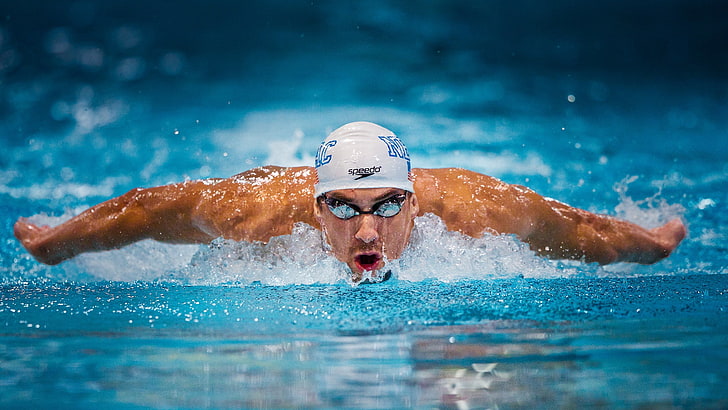
Swimming is a team or individual sport that involves moving through water while using one’s full body. The game is played in open water or swimming pools (e.g., in a sea or lake). One of the most well-liked Olympic sports is competitive swimming, which features a variety of distance events in the butterfly, backstroke, breaststroke, freestyle, and individual medley strokes. In addition to these individual competitions, a freestyle or medley relay can be entered by four swimmers. A medley relay includes of four swimmers who will swim backstroke, breaststroke, butterfly, and freestyle in that order.
Each stroke in swimming involves a specialized set of techniques, and in competition there are strict rules governing the proper form for each individual stroke. Additionally, there are rules governing the kinds of swimsuits, headgear, jewelry, and injury tape that are acceptable at events. Although there are a number of injuries that competitive swimmers may sustain from the activity, such as tendinitis in the shoulders or knees, there are also a number of health advantages to the sport.
The body moves forward during swimming by repeating movements called strokes. There are four main strokes, although the front crawl, often known as freestyle, is generally regarded as the quickest. However, additional strokes are performed for specific reasons, such as training.
Swimming has a number of risks, primarily because it is done in water. Swimmers run the risk of becoming incapacitated from fear and exertion, which could result in drowning death. Other risks include contracting an infection or coming into contact with noxious aquatic life. Most facilities employ a lifeguard to watch for indications of distress in order to reduce these hazards.
Although swimmers frequently wear specialized swimwear, some swimmers may also swim nude or in their regular clothes, depending on the local culture. Additionally, a variety of equipment, such as swim fins, snorkels, floating devices, and swimming goggles, among others, can be utilized to improve swimming performance or experience.
Instruction and training
Both sports and lifesaving teaching programs began in Great Britain in the 19th century. The rest of Europe copied those programs. Under the direction of the American Red Cross, swimming lessons for lifesaving purposes were first offered in the United States in 1916. Swimming was strongly encouraged by the instructional work carried out by the various branches of the armed forces throughout both World Wars I and II. It became customary for community organizations and institutions to offer classes that eventually included very young newborns.
By the late 1950s, interval training and repetition training had taken the place of the traditional method of simply swimming as much as possible during every workout. A sequence of swims over the same distance interspersed with planned rest times make up interval training. The rest period in slow interval training, which is largely intended to build endurance, is never longer than it takes to swim the designated distance. Fast interval training, which is primarily utilized to increase speed, allows for rest intervals that are long enough to almost completely restore the heart and respiratory rates.
Health benefits of swimming
Swimming is a great workout because you need to move your whole body against the resistance of the water.
Swimming is a good all-round activity because it:
•Maintaining a healthy weight, heart, and lungs is made easier by swimming, which also:
•keeps your heart rate up while reducing some of the impact stress on your body;
•improves endurance, muscle strength, and cardiovascular fitness; •tones and strengthens your muscles;
•gives you an all-over body workout because swimming uses nearly all of your muscles.
Techniques
Freestyle
The swimmer pushes off while holding his breath, stretches his body fully, and then dives into the water. He or she descends to a certain depth before rising to the surface by flapping the legs. To advance, hands are alternately lifted forward. Only with his head underwater can the swimmer exhale. He touches the wall with any part of his body when he reaches the opposite end of the pool, at which point he somersaults to shift his body back in the original direction.
Backstroke
One of the less well-known strokes involves the swimmer swimming on their back while flailing their legs and propelling themselves ahead with their hands. Unlike freestyle, this stroke has a distinct starting position. The swimmer braces his feet on the underwater wall while maintaining his grip on the departure. He releases his hold at the signal and pushes off his legs on the wall to dive headfirst into the sea. After diving in, the swimmer begins flailing his arms alternately to advance before flailing his feet to reach the surface. He turns onto his stomach and contacts the wall with any part of his body after reaching the opposite end (mostly by feet). He needs to get back to the backdown position before backing away from the wall.
Breaststroke
The swimmer pushes off his body after receiving the signal, dives into the water, and then propels himself forward by dragging his arms inward, downward, and then inward before kicking with his legs. The swimmer must touch the wall with both hands at the opposite end of the pool and then return to the horizontal posture before leaving it. An “Open Turn” is the name for this style of turn.
Butterfly Stroke
The swimmer moves both of his arms in a symmetrical rhythm, similar to breaststroke and freestyle, keeping the shoulder horizontal to the water’s surface and moving his legs in synchronization to resemble a dolphin. At the end of the stroke, the swimmer inhales while raising his arms above his head. He touches the wall with both of his hands when he reaches the pool’s end and then pushes off the wall with his feet. He swims in a similar fashion while moving with his stomach down while using dolphin kicks to finish the race.
Safety
Principal Concept: Drowning
One of the main dangers of swimming, a widely practiced recreational activity around the world, is drowning. Inexperience in the water or exhaustion from swimming are two common causes of drowning. In the United States, fatal unintentional drownings claimed an average of 3,536 lives from 2005 to 2014, or almost 10 people each day.
In order to reduce the risk and stop potential drownings, lifeguards are frequently hired to watch over swimming areas such pools, waterparks, lakes, and beaches. Depending on the locations where they work, different lifeguards receive varied training; for example, a waterfront lifeguard receives more intense training than a poolside lifeguard. The National Lifesaving Society and the Canadian Red Cross, both of which specialize in teaching lifeguards in North America, are well-known providers of aquatic training services.
Swimwear
Swimsuit
Competitive swimwear aims to be faster and more covered than naked skin. Because polyurethane suits made athletes more buoyant, FINA rules and regulations were changed and they were outlawed in 2009. Additionally, these regulations prohibited suits that conceal the neck or extend past the shoulders for women and the navel for men.
Swim cap
The swimmer’s hair is kept out of the way by a swim cap to reduce drag. Caps can be constructed of silicone, spandex, lycra, or latex.
Goggles
Swimmers’ eyes are protected from chlorine and water with goggles. At outdoor pools, goggles may be colored to reduce glare. Swimmers who have corrective lenses may wear prescription goggles.
Swim Fins
Although they are prohibited in a race, rubber fins are used to aid in faster kicking as well as to develop strength and technique. They also enhance technique by ensuring that the feet are placed correctly while kicking.
Drag suit
Drag suits are used by swimmers during practice to improve resistance. As a result, a swimmer can practice at a higher level of difficulty and experience less resistance while competing. Competitive races do not involve the use of drag suits.
Hand paddles
These plastic implements are used by swimmers to develop their arm and shoulder strength and improve their hand-pulling technique. Hand paddles are attached to the hand using elastic or rubber tubing. Depending on the swimmer’s taste and hand size, they come in a wide variety of sizes and shapes.
Kickboard
Swimmers use a foam board known as a kickboard to support their upper bodies while they concentrate on kicking. Kicking is a single-leg motion that helps build leg muscle for future strength.
Pull buoy
Pull buoys support swimmers’ legs (and keep them from kicking) as they concentrate on pulling and are frequently used in tandem with hand paddles. The foam used to make pull buoys allows them to float in the water. They are held between the thighs by swimmers. To make kicking a little more difficult, you may also use them as a kickboard.
Ankle bands
Enhancing balance can reduce the kick’s requirement to give an upward vector rather than a forward one and, in some situations, entirely correct the kick. By immediately stopping your kick when you use an ankle band, you are then forced to work to right your balance. If you are able to locate these, then the ankle band has partially served its purpose.
Snorkel
A snorkel is a piece of plastic that facilitates breathing when swimming. The swimmer can practice maintaining head stability while using this piece of equipment, which also teaches them how to breathe correctly by inhaling through the mouth and exhaling through the nose. This method is the opposite of the typical breathing pattern used by runners, which is inhalation through the nose and exhalation through the mouth.

5 comments on “Everything You Need To Know About Swimming”
gostopsite com
5월 7, 2023 at 7:34 오전Check into residential care facilities in your neighbourhood if your loved one needs to transfer 섯다
sportstotomen com
5월 7, 2023 at 7:35 오전If your loved one has advanced care needs, then personal care could be the right choice. 스포츠토토
19guide03 com
5월 7, 2023 at 7:41 오전but it also helps with tasks such as grooming, dressing, bathing, and mobility. 성인웹툰
casinosite zone
5월 7, 2023 at 7:42 오전service and recommend carrying on such applauding post. 온라인카지노
sportstotozone com
5월 7, 2023 at 7:43 오전The technical knowledge that is showcased through this blog is quite informative. 토토